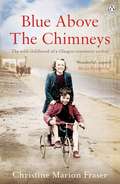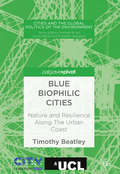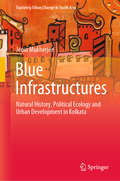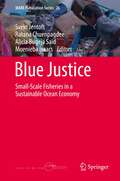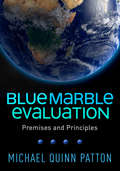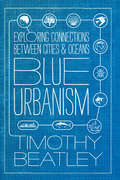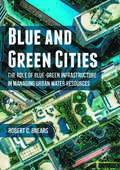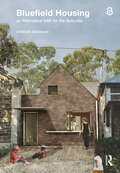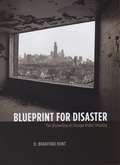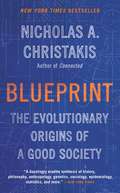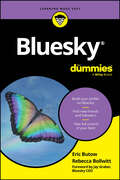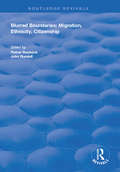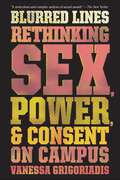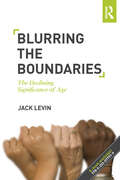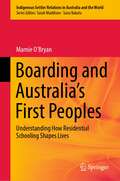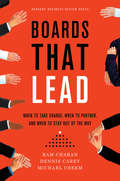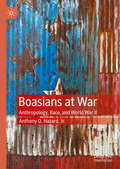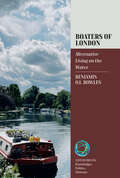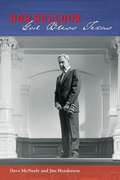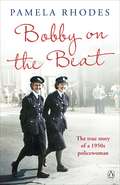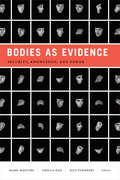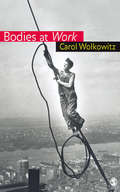- Table View
- List View
Blue Above the Chimneys
by Christine Marion FraserDiscover the heart-warming and uplifting story of a Glasgow tenement urchin finding her way against adversity Born during the Second World War in Glasgow, Christine Fraser was her mother's eighth child.Growing up with her siblings in a tiny flat, learning to avoid her hardworking, hard-drinking one-eyed father, making a menace of herself in the streets along with the other urchins, Christine lived an impoverished life but never once cared.Until she was struck down by a terrible illness.Suddenly, her wild days of childhood were over. A long spell in hospital completely changed her life. Now she found herself dependent on others for so many of her needs. And on top of that, her mother and father have died.Yet Christine was always resourceful and never once looked down.She knew that always there, if you looked hard enough, was some blue up above the chimneys . . .Readers are captivated by Blue Above the Chimneys'Keeps you enthralled from the first to the last chapter' 5***** Reader Review'Christine wrote with so much passion that you could envisage each and every scene' 5***** Reader Review'A joyous read' 5***** Reader Review
Blue Biophilic Cities: Nature and Resilience Along The Urban Coast (Cities and the Global Politics of the Environment)
by Timothy BeatleyThere is a growing recognition of the contact we need with nature to be happy, healthy and to lead meaningful lives. We need that nature daily, if not hourly, and so it must be nearby to where we live and work. This is central to the concept of 'biophilic cities' which is emerging as a global movement and guiding framework for city design and planning. Blue Biophilic Cities is about the promise of this movement and a kind of biophilic urbanism that is possible for cities perched on the edge of harbours and seas. In blue biophilic cities, much of the nearby nature is to be found in the marine realm. This book explores the efforts underway in a number of cities to foster new marine connections through a variety of innovative programs and initiatives. It also discusses a number of design ideas, from dynamic shoreline edges and floodable parks to living breakwaters, in order to emphasise the possibility of designing for resilience while also supporting marine biodiversity and strengthening biophilic connections to the marine world.
Blue Infrastructures: Natural History, Political Ecology and Urban Development in Kolkata (Exploring Urban Change in South Asia)
by Jenia MukherjeeThis book focuses on Kolkata, formerly the colonial capital of and currently a major megacity in India, in terms of its extensive blue infrastructures, i.e., its rivers, canals and wetlands as an integrated composite whole. It unfolds ways in which this reclaimed urban space could determine, and in turn, could get determined by political fate, economic calculations and social livelihoods across changing political-economic imperatives and with large-scale implications on urban sustainability. Employing historical urban political ecology (HUPE) as the methodological framework by combining urban environmental history and urban political ecology, the book studies the changing urban environmental equations through several centuries, and its impact on the city and its people. Weaving the past, present and posterity of deltaic Kolkata, the book demonstrates that it is in these ‘blue infrastructures’ that the anecdote of origin, the account of functioning and the apprehension of survival of the city is rooted. By emphasizing the ecology ‘of’ cities instead of ecology ‘in’ cities approach, the book exposes the limitations of contemporary ecological restructuring efforts regarding Indian cities. Further, it offers a blueprint for future innovative and empirical research focusing on other major cities. Accordingly, this topical and original book will be of interest to students and researchers of environmental humanities, political ecology and urban studies.
Blue Justice: Small-Scale Fisheries in a Sustainable Ocean Economy (MARE Publication Series #26)
by Svein Jentoft Ratana Chuenpagdee Alicia Bugeja-Said Moenieba IsaacsFor small-scale fisheries around the world, the Blue Growth and Blue Economy initiatives may provide sustainable development, but only insofar as they align with the global consensus enshrined in the Voluntary Guidelines for Securing Sustainable Small-Scale Fisheries in the context of Food Security and Poverty Eradication. If states do nothing to fulfill the promises they made when they endorsed these guidelines in 2014, the Blue Economy will come at a loss for small-scale fisheries and further their marginalization in the ocean economy. Under the umbrella of Blue Justice, this book demonstrates that these risks are real and must be considered as states implement their sustainable ocean development plans. These are human rights issues, which are embedded into governance principles and institutions and which make a difference for small-scale fisheries people in their daily lives. In stressing the importance of policies and institutions that build on the experiences of small-scale fisheries people in the contexts in which they operate, this book draws on case studies of small-scale fisheries from countries on all continents to clarify what Blue Justice entails for small-scale fisheries and make suggestions for real change. “Through the Blue Justice paradigm, this book flags the relevance of recognizing the potential impact that different factors, including the Blue Economy approach, could bring to fishing communities, their livelihoods, cultural traditions, and other potential multidimensional conflicts. Vulnerability in fishing communities can increase and inequalities can be reinforced at different levels if individuals and community capabilities are not strengthened… A first of its kind, not to be missed, this book is informative, purposeful, and pertinent in an era of change”. Silvia Salas, CINVESTAV, Marine Resources Department, Mérida, Mexico "The studies reveal that Blue Justice is a ‘governability’ issue, which requires establishing ‘right’ institutions, that are transdisciplinary (integrated), participatory, and holistic. It is implicit from these writings that the SSF Guidelines and Blue Growth initiatives do not form two different discourses, and that the implementation of the former would resolve many of the justice issues caused by the latter, in favor of small-scale fisheries and their communities". Oscar Amarasinghe, Professor & Chancellor, Ocean University of Sri Lanka and President, Sri Lanka Forum for Small Scale Fisheries (SLFSSF)
Blue Marble Evaluation: Premises and Principles
by Michael Quinn PattonAs a transdisciplinary profession, evaluation has much to offer to global change interventions that work toward a sustainable future across national boundaries, sectors, and issues. This book introduces Blue Marble evaluation, which provides a framework for developing, adapting, and evaluating major systems change initiatives involving complex networks of stakeholders. Michael Quinn Patton demonstrates how the four overarching principles and 12 operating principles of this innovative approach allow evaluators, planners, and implementers to home in on sustainability and equity issues in an intervention. Compelling case examples, bulleted review lists, charts, and 80 original exhibits and graphics connect the global and local, the human and ecological. Rooted in utilization-focused, developmental, and principles-focused evaluation, Blue Marble evaluation is designed to tackle problems outside the reach of traditional evaluation practice.
Blue Urbanism: Exploring Connections Between Cities and Oceans
by Timothy BeatleyWhat would it mean to live in cities designed to foster feelings of connectedness to the ocean? As coastal cities begin planning for climate change and rising sea levels, author Timothy Beatley sees opportunities for rethinking the relationship between urban development and the ocean. Modern society is more dependent upon ocean resources than people are commonly aware of--from oil and gas extraction to wind energy, to the vast amounts of fish harvested globally, to medicinal compounds derived from sea creatures, and more. In Blue Urbanism, Beatley argues that, given all we've gained from the sea, city policies, plans, and daily urban life should acknowledge and support a healthy ocean environment. The book explores issues ranging from urban design and land use, to resource extraction and renewable energy, to educating urbanites about the wonders of marine life. Chapters delve into topics like the emerging practices of "community supported fisheries" and aquaponics, incentives for increasing use of wind and tidal energy as renewable options to oil and gas extraction that damages ocean life, and how the shipping industry is becoming more "green. " Additionally, urban citizens, Beatley explains, have many opportunities to interact meaningfully with the ocean, from beach cleanups to helping scientists gather data. Ultimately, he explains that we must create a culture of "ocean literacy" using a variety of approaches, from building design and art installations that draw inspiration from marine forms, to encouraging citizen volunteerism related to oceans, to city-sponsored research, and support for new laws that protect marine health. Equal parts inspiration and practical advice for urban planners, ocean activists, and policymakers, Blue Urbanism offers a comprehensive look at the challenges and great potential for urban areas to integrate ocean health into their policy and planning goals.
Blue and Green Cities: The Role Of Blue-green Infrastructure In Managing Urban Water Resources
by Robert C. BrearsThis book offers new research on urban policy innovations that promote the application of blue-green infrastructure in managing water resources sustainably. The author argues that urban water managers have traditionally relied on grey infrastructural solutions to mitigate risks with numerous economic and environmental consequences. Brears explores the role urban water managers have in implementing blue-green infrastructure to reduce ecological damage and mitigate risk. The case studies in this book illustrate how cities, of differing climates, lifestyles and income-levels, have implemented policy innovations that promote the application of blue-green infrastructure in managing water, wastewater and stormwater sustainably to reduce environmental degradation and enhance resilience to climate change. This new research on urban policy innovations that promote the application of blue-green infrastructure in managing water resources sustainably will be of interest to those working on water conservation and policy.
Blue and Green Cities: The Role of Blue-Green Infrastructure in Managing Urban Water Resources
by Robert C. BrearsA completely revised and updated new edition of this successful book focused on urban policy innovations that promote the application of blue-green infrastructure in managing water resources sustainably. Since the first edition published, nature-based solutions in general and blue-green infrastructure, in particular, have become a more recognised solution to various societal challenges, including mitigating climatic extremes in cities while restoring the natural environment and enhancing biodiversity. This new edition provides updated research on urban policy innovations that promote the application of BGI in managing water resources sustainably. In particular, the book contains case studies that illustrate how cities of differing climates, lifestyles and income levels have implemented policy innovations that promote the application of BGI in managing water, wastewater and stormwater sustainably to enhance resilience to climate change and reduce environmental degradation. The seven case studies are leading cities that have implemented various fiscal and non-fiscal policy tools to encourage the implementation of BGI on both public and private property to reduce stormwater runoff volumes, enhance the health of waterways, enhance resilience to climate change and meet regulatory requirements.
Bluefield Housing as Alternative Infill for the Suburbs
by Damian MadiganSuburbanised cities share a common dilemma: how to transition to more densely populated and socially connected urban systems while retaining low-rise character, avoiding gentrification, and opening neighbourhoods to more diverse housing choices. Bluefield Housing offers a new land definition and co-located infill model addressing these concerns, through describing and deploying the types of ad-hoc modifications that have been undertaken in the suburbs for decades. Extending green-, brown-, and greyfield definitions, it provides a necessary middle ground between the ‘do nothing’ attitude of suburban preservation and the ‘do everything’ approach of knock-down-rebuild regeneration. An adjunct to ‘missing middle’ and subdivision densification models, with a focus on co-locating homes on small lots, Bluefield Housing presents a unified design approach to suburban infill: retrofitting original houses, retaining and enhancing landscape and urban tree canopies, and delivering additional homes as low-rise additions and backyard homes suited to the increasingly complex make-up of our households. Extensively illustrated by the author with engaging architectural design studies, Damian Madigan describes how existing quirks of suburban housing can prompt new forms of infill, explains why a new suburban densification model is not only necessary but can be made desirable for varied stakeholders, and charts a path towards the types of statutory and market triggers required to make bluefield housing achievable. Using Australian housing as an example but addressing universal concerns around neighbourhood character, demographic needs, housing diversity, dwelling flexibility, and landscape amenity, Bluefield Housing offers innovative suburban infill ideas for policy makers, planners, architects, researchers and students of housing and design studies, and for those with a stake in the future of the suburbs.
Bluefield Housing as Alternative Infill for the Suburbs
by Damian MadiganSuburbanised cities share a common dilemma: how to transition to more densely populated and socially connected urban systems while retaining low-rise character, avoiding gentrification, and opening neighbourhoods to more diverse housing choices. Bluefield Housing offers a new land definition and co-located infill model addressing these concerns, through describing and deploying the types of ad-hoc modifications that have been undertaken in the suburbs for decades. Extending green-, brown-, and greyfield definitions, it provides a necessary middle ground between the ‘do nothing’ attitude of suburban preservation and the ‘do everything’ approach of knock-down-rebuild regeneration.An adjunct to ‘missing middle’ and subdivision densification models, with a focus on co-locating homes on small lots, Bluefield Housing presents a unified design approach to suburban infill: retrofitting original houses, retaining and enhancing landscape and urban tree canopies, and delivering additional homes as low-rise additions and backyard homes suited to the increasingly complex make-up of our households.Extensively illustrated by the author with engaging architectural design studies, Damian Madigan describes how existing quirks of suburban housing can prompt new forms of infill, explains why a new suburban densification model is not only necessary but can be made desirable for varied stakeholders, and charts a path towards the types of statutory and market triggers required to make bluefield housing achievable. Using Australian housing as an example but addressing universal concerns around neighbourhood character, demographic needs, housing diversity, dwelling flexibility, and landscape amenity, Bluefield Housing offers innovative suburban infill ideas for policy makers, planners, architects, researchers and students of housing and design studies, and for those with a stake in the future of the suburbs.The Open Access version of this book, available at www.taylorfrancis.com, has been made available under a Creative Commons Attribution-Non Commercial-No Derivatives (CC-BY-NC-ND) 4.0 license.
Blueprint for Disaster: The Unraveling of Chicago Public Housing
by D. Bradford HuntNow considered a dysfunctional mess, Chicago's public housing projects once had long waiting lists of would-be residents hoping to leave the slums behind. So what went wrong? To answer this complicated question, D. Bradford Hunt traces public housing's history in Chicago from its New Deal roots through current mayor Richard M. Daley's Plan for Transformation. In the process, he chronicles the Chicago Housing Authority's own transformation from the city's most progressive government agency to its largest slumlord. Challenging explanations that attribute the projects' decline primarily to racial discrimination and real estate interests, Hunt argues that well-intentioned but misguided policy decisions- ranging from design choices to maintenance contracts- also paved the road to failure. Moreover, administrators who fully understood the potential drawbacks did not try to halt such deeply flawed projects as Cabrini-Green and the Robert Taylor Homes. These massive high-rise complexes housed unprecedented numbers of children but relatively few adults, engendering disorder that pushed out the working class and, consequently, the rents needed to maintain the buildings. The resulting combination of fiscal crisis, managerial incompetence, and social unrest plunged the CHA into a quagmire from which it is still struggling to emerge. Blueprint for Disaster, then,is an urgent reminder of the havoc poorly conceived policy can wreak on our most vulnerable citizens.
Blueprint: The Evolutionary Origins of a Good Society
by Nicholas A. ChristakisDrawing on advances in social science, evolutionary biology, genetics, neuroscience, and network science, Blueprint shows how and why evolution has placed us on a humane path -- and how we are united by our common humanity. For too long, scientists have focused on the dark side of our biological heritage: our capacity for aggression, cruelty, prejudice, and self-interest. <P><P>But natural selection has given us a suite of beneficial social features, including our capacity for love, friendship, cooperation, and learning. Beneath all our inventions -- our tools, farms, machines, cities, nations -- we carry with us innate proclivities to make a good society. <P><P> In Blueprint, Nicholas A. Christakis introduces the compelling idea that our genes affect not only our bodies and behaviors, but also the ways in which we make societies, ones that are surprisingly similar worldwide. <P><P>With many vivid examples -- including diverse historical and contemporary cultures, communities formed in the wake of shipwrecks, commune dwellers seeking utopia, online groups thrown together by design or involving artificially intelligent bots, and even the tender and complex social arrangements of elephants and dolphins that so resemble our own -- Christakis shows that, despite a human history replete with violence, we cannot escape our social blueprint for goodness. <P><P>In a world of increasing political and economic polarization, it's tempting to ignore the positive role of our evolutionary past. But by exploring the ancient roots of goodness in civilization, Blueprint shows that our genes have shaped societies for our welfare and that, in a feedback loop stretching back many thousands of years, societies have shaped, and are still shaping, our genes today. <P><b>A New York Times Bestseller</b>
Bluesky For Dummies
by Eric Butow Rebecca BollwittThe first and most trustworthy guide to the hot new social media platform Bluesky has been taking the social media world by storm. The platform offers users a high degree of control over what information they view and share, abilities they've lost on other platforms. Bluesky For Dummies serves as your guidebook to navigating the new platform. Learn to import your contacts, control your feed, and share content, with easy-to-follow instructions. This book also shows you how to manage who can contact you and access your content, so you can avoid bots, trolls, and other unsavory characters. For business owners, this Dummies guide is a breath of fresh air—learn how to set up Bluesky for your business and enjoy a peaceful and profitable social experience. Discover how Bluesky differs from the other social media apps out there Create a profile, make connections, share your content, and build a following Take control of your social media experience with access and content settings Connect with users by exploring custom lists and feeds Refugees from other social media sites, as well as social media beginners, can find out what it's like to be social without the downsides, thanks to Bluesky For Dummies.
Blurred Boundaries: Migration, Ethnicity, Citizenship (Routledge Revivals)
by Rainer Bauböck John RundellFirst published in 1999, this volume examines new forms of cultural diversity which result from migration and globalization. Historically, most liberal democracies have developed on the basis of national cultures – either a single one, or a dominant one, or a federation of several ones. However, political and economic developments have upset traditional patterns and have blurred established boundaries. Ongoing immigration from diverse origins has inserted new ethnic minorities into formerly homogenous populations. Democratic liberties and rights provided opportunities for old and new marginalized minorities to resist assimilation and to assert identities. The resulting pattern of multiculturalism is different from earlier ones. Often cultural boundaries are neither clearly defined nor do they simply dissolve by assimilation into a dominant group – they have become fuzzy and a constant source of real or imagined hostility and anxiety. A proliferation of mixed identities goes together with stronger claims for cultural rights and escalating hostilities between ethnic minorities and national majorities. In many countries multiculturalism is today perceived as a challenge rather than as an enrichment. The book focuses on the question how institution and policies of liberal democracies can cope with these trends. The book addresses two tasks: 1) To compare different national contexts and types of ethnic groups (immigrant and indigenous, linguistic and religious minorities) and to discuss how policies of multicultural integration have to be adapted in order to cope with such differences. 2) To evaluate the impact of common rends of globalization which link societies and encourage convergence between national models of multicultural integration.
Blurred Lines: Rethinking Sex, Power, & Consent on Campus
by Vanessa GrigoriadisA new sexual revolution is sweeping the country, and college students are on the front lines. Few places in America have felt the influence of #MeToo more intensely. Indeed, college campuses were in many ways the harbingers of #MeToo. Grigoriadis captures the nature of this cultural reckoning without shying away from its complexity. College women use fresh, smart methods to fight entrenched sexism and sexual assault even as they celebrate their own sexuality as never before. Many &“woke&” male students are more open to feminism than ever, while others perpetuate the cruelest misogyny. Coexisting uneasily, these students are nevertheless rewriting long-standing rules of sex and power from scratch. Eschewing any political agenda, Grigoriadis travels to schools large and small, embedding in their social whirl and talking candidly with dozens of students, as well as to administrators, parents, and researchers. Blurred Lines is a riveting, indispensable illumination of the most crucial social change on campus in a generation.
Blurring The Boundaries: The Declining Significance of Age
by Jack LevinOver the decades, the lines separating young- middle-aged-, and older adults have blurred, as indicated by a broadening of the appropriate years for making life decisions. Not only are many people marrying later, but some are marrying earlier than ever. Overall, women giving birth later, but some are having children earlier in their lives. Older people are retiring later, but some are retiring at a younger age. The spread or variability (standard deviation) of age-based decisions has increased substantially, giving adults greater freedom from the traditional constraints of age. With these relaxed age norms has come a host of related social problems. The relaxation of age norms for adult decision-making has inadvertently blurred the boundaries between adults and teenagers, between teenagers and children. This generalization of the phenomenon throughout the life cycle is responsible for the adultification of childhood. Eight year old girls are, to an increasing extent, being treated as sexual objects; bullying peaks in the 6th grade; larger numbers of girls are having oral sex or sexual intercourse by the age of 15; the pregnancy rate for girls 13-15 is on the rise; we are in the process of dismantling the juvenile justice system in favor of adult forms of punishment; and more and more children are left without adult supervision in the afternoons, as though they were miniature adults who are capable of raising themselves. Jack Levin is the American Sociological Association’s 2009 Winner of the “Public Understanding of Sociology” Award. This short book communicates the power and importance of sociological thinking to major, worldwide social trends. Ideal for use in undergraduate courses such as introductory sociology, social problems, and social change as well as more advanced courses in population, or sociology of aging.
Boarding and Australia's First Peoples: Understanding How Residential Schooling Shapes Lives (Indigenous-Settler Relations in Australia and the World #3)
by Marnie O’BryanThis book takes us inside the complex lived experience of being a First Nations student in predominantly non-Indigenous schools in Australia. Built around the first-hand narratives of Aboriginal and Torres Strait Islander alumni from across the nation, scholarly analysis is layered with personal accounts and reflections. The result is a wide ranging and longitudinal exploration of the enduring impact of years spent boarding which challenges narrow and exclusively empirical measures currently used to define ‘success’ in education. Used as instruments of repression and assimilation, boarding, or residential, schools have played a long and contentious role throughout the settler-colonial world. In Canada and North America, the full scale of human tragedy associated with residential schools is still being exposed. By contrast, in contemporary Australia, boarding schools are characterised as beacons of opportunity and hope; places of empowerment and, in the best, of cultural restitution. In this work, young people interviewed over a span of seven years reflect, in real time, on the intended and unintended consequences boarding has had in their own lives. They relate expected and dramatically unexpected outcomes. They speak to the long-term benefits of education, and to the intergenerational reach of education policy. This book assists practitioners and policy makers to critically review the structures, policies, and cultural assumptions embedded in the institutions in which they work, to the benefit of First Nations students and their families. It encourages new and collaborative approaches Indigenous education programs.
Boards That Lead
by Ram Charan Michael Useem Dennis CareyIs your firm's board creating value-or destroying it?Change is coming. Leadership at the top is being redefined as boards take a more active role in decisions that once belonged solely to the CEO. But for all the advantages of increased board engagement, it can create debilitating questions of authority and dangerous meddling in day-to-day operations. Directors need a new road map-for when to lead, when to partner, and when to stay out of the way.Boardroom veterans Ram Charan, Dennis Carey, and Michael Useem advocate this new governance model-a sharp departure from what has been demanded by governance activists, raters, and regulators-and reveal the emerging practices that are defining shared leadership of directors and executives. Based on personal interviews and the authors' broad and deep experience working with executives and directors from dozens of the world's largest firms, including Apple, Boeing, Ford, Infosys, and Lenovo, Boards That Lead tells the inside story behind the successes and pitfalls of this new leadership model and explains how to: Define the central idea of the company Ensure that the right CEO is in place and potential successors are identified Recruit directors who add value Root out board dysfunction Select a board leader who deftly bridges the divide between management and the board Set a high bar on ethics and riskWith a total of eighteen checklists that will transform board directors from monitors to leaders, Charan, Carey, and Useem provide a smart and practical guide for businesspeople everywhere-whether they occupy the boardroom or the C-suite.
Boasians at War: Anthropology, Race, and World War II
by Anthony Q. Hazard, Jr.This volume seeks to recover a specific historical moment within the tradition of anthropologists trained in the United States under Franz Boas, arguably the father of modern American anthropology. Focusing on Boasians Ashley Montagu, Margaret Mead, Melville Herskovits, and Ruth Benedict, Anthony Hazard highlights the extent to which the Boasians offer historicized explanations of racism that move beyond a quest to reshape only the discipline: Boasian war work pointed to the histories of chattel slavery and colonialism to theorize not just race, but the emergence of racism as both systemic and interpersonal. The realities of race that continue to plague the United States have direct ties to the anthropological work of the figures examined here, particularly within the context of the 20th-century black freedom struggle. Ultimately, Boasians at War offers a detailed glimpse of the long troubled history of the concept of race, along with the real-life realities of racism, that have carried on despite the harnessing of scientific knowledge to combat both.
Boaters of London: Alternative Living on the Water (Lifeworlds: Knowledges, Politics, Histories #5)
by Ben BowlesLondon and the Southeast of England is home to an alternative community of people called 'boaters': individuals and families who live on narrowboats, cruisers and barges, along a network of canals and rivers. Many of these people move from place to place every two weeks due to mooring rules and form itinerant communities in the heart of some of the UK’s most built-up and expensive urban spaces. Boaters of London is an ethnography that delves into the process of becoming a boater, adopting an alternative lifestyle on the water and the political impact that this travelling population has on the state.
Bob Bullock
by Dave McneelyRenowned for his fierce devotion to the people of Texas—as well as his equally fierce rages and unpredictable temper—Bob Bullock was the most powerful political figure in Texas at the end of the twentieth century. First elected to the Texas House of Representatives in 1956, Bullock held several key statewide posts before capturing the lieutenant governor’s office in 1990. Though nominally the state’s number two official, Bullock in fact became Texas’s top power broker, wielding tremendous influence over the legislative agenda and state budget through the 1990s while also mentoring and supporting a future president—George W. Bush. In this lively, yet thoroughly researched biography, award-winning journalists Dave McNeely and Jim Henderson craft a well-rounded portrait of Bob Bullock, underscoring both his political adroitness and his personal demons. They trace Bullock’s rise through state government as Assistant Attorney General, Secretary of State, State Comptroller, and Lieutenant Governor, showing how he increased the power of every office he held. The authors spotlight Bullock’s substantial achievements, which included hiring an unprecedented number of women and minorities, instituting a performance review to increase the efficiency of state agencies, restructuring the public school funding system, and creating the state’s first water conservation and management plan.
Bobby on the Beat
by Pamela RhodesPamela Rhodes, one of the first British policewomen, tells her fascinating story in Bobby on the Beat.Back in 1950 Pam became one of the first policewomen in the country. But the force's new female recruits faced a sceptical public in rural Yorkshire and even before they stepped out on the beat there were the prejudices of older male officers to overcome.Yet from the first Pam was thrust into the front line. From runaway bulls to investigating ladies of the night and cases of vice, her innocent eyes were quickly opened. And soon, spending her days on the streets, she came to know the neighbourhood and the extraordinary characters who lived on the right, as well as wrong, side of the law.In the charming Bobby on the Beat, Pamela Rhodes's tales of life as a copper provide a fascinating glimpse of country life now long gone - when seeing a bobby on the beat meant all was well.Pamela Rhodes lives in Scarborough, where she was one of the first WPCs in Britain in the 1960s. Her unique story was picked up when she entered the life-story competition run by Penguin and Saga Magazine, in which she placed as a runner-up. This is her first memoir.
Bodies as Evidence: Security, Knowledge, and Power (Global Insecurities)
by Ursula Rao Mark Maguire Nils ZurawskiFrom biometrics to predictive policing, contemporary security relies on sophisticated scientific evidence-gathering and knowledge-making focused on the human body. Bringing together new anthropological perspectives on the complexities of security in the present moment, the contributors to Bodies as Evidence reveal how bodies have become critical sources of evidence that is organized and deployed to classify, recognize, and manage human life. Through global case studies that explore biometric identification, border control, forensics, predictive policing, and counterterrorism, the contributors show how security discourses and practices that target the body contribute to new configurations of knowledge and power. At the same time, margins of error, unreliable technologies, and a growing suspicion of scientific evidence in a “post-truth” era contribute to growing insecurity, especially among marginalized populations. Contributors. Carolina Alonso-Bejarano, Gregory Feldman, Francisco J. Ferrándiz, Daniel M. Goldstein, Ieva Jusionyte, Amade M’charek, Mark Maguire, Joseph P. Masco, Ursula Rao, Antonius C. G. M. Robben, Joseba Zulaika, Nils Zurawski
Bodies at Risk: An Ethnography of Heart Disease
by Elizabeth E. WheatleyIn Bodies at Risk, Elizabeth Wheatley provides a fascinating ethnography of heart disease. She looks at what happens to someone after a heart attack and how they get on with 'business as usual' in the wake of a potentially fatal medical crisis. How are daily routines, personal identities, families, friends, and careers affected and rearranged after diagnosis and treatment? This book examines the unfinished business of having and handling heart disease. The research is based on one-on-one and collective interviews, focus groups and participant observation in hospitals, cardiac rehabilitation clinics, and in people's homes. As heart disease is one of the major causes of death in the western world, this book is both timely and important. It is inspired by and contributes to sociological writing on the body, risk, experiences of illness, and medicalization, and will appeal to academics and students in these areas as well as in cultural studies, health-related consumption, health promotion and qualitative health research.
Bodies at Work (Sociology Ser.)
by Dr Carol Wolkowitz'After reading this book it will be more difficult to "do" the sociology of work and the sociology of the body in the absence of the other. In some quite exquisite ways it throws down a challenge which practitioners in both fields will find difficult to ignore' - Paul Stewart, former editor of Work, Employment and Society, University of the West of England Bodies at Work provides the first full-length, accessible account of the body/work relation in contemporary western societies. Bringing together fields of sociology that have hitherto developed mainly along separate lines, the book demonstrates the relevance of concepts developed in the sociology of the body for enriching our understanding of changing patterns of work and employment. Bodies at Work begins by establishing key concerns in both the sociology of the body and the sociology of work. Drawing on existing research, the author proceeds to examine a wide range of employment sectors: industrial employment; customer relations; health practice; care work; the beauty industry; and sex work. The contribution of feminist theory and research is highlighted throughout, and analyses of photographs help the reader conceptualise the changing nature of the body/work relationship over time. Bodies at Work helps readers think more clearly and creatively about how work relations shape bodily experience.
